This gingerbread layer cake is perfect for the holidays! It bakes up so delicious and is frosted with the best cream cheese frosting.
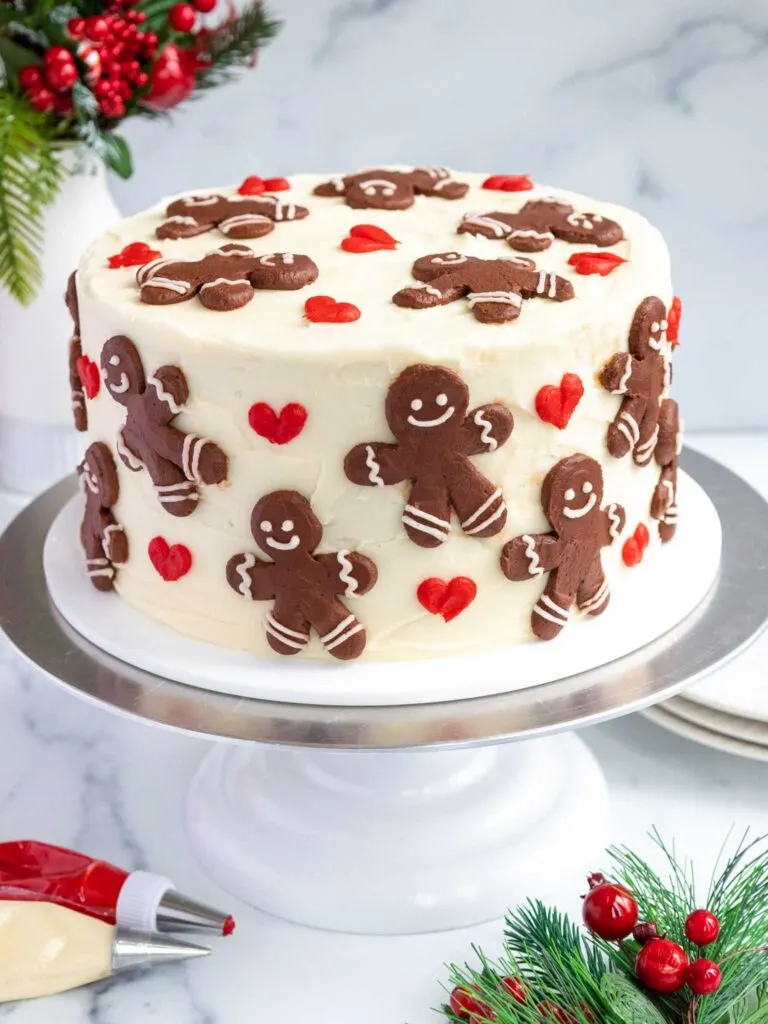
How to Make This Gingerbread Layer Cake
To make sure this gingerbread layer cake turns out as amazing as possible, let’s walk through each step together! I’ve also included a video tutorial of the process below.
I figured it might be helpful to know what tools I use too, so I’ve shared a list below.
Not all of these are mandatory, but they make the process a lot easier. If you don’t have all these things on hand, feel free to improvise and work with what you have.
- 3, 8-inch cake pans
- Serrated Knife
- Spinning cake stand
- Electric hand mixer or stand mixer
- 10-inch greaseproof cake board
- Large offset spatula
- 3 Small piping bags (12-inch)
- 2 Small round piping tips (like a Wilton 10)
- 1 Very small round piping tip (like a Wilton 3)
Step 1: Bake the Gingerbread Cake Layers
First, we make the gingerbread cake batter following the recipe card at the bottom of this post.
Divide the batter evenly between the prepared cake pans and bake for 31-34 minutes or until a toothpick comes out with a few moist crumbs.
Remove the cake layers from the oven and let them cool in the pans for about 10 minutes.
Gently run an offset spatula around the rim of the cake pans to loosen them, then flip them into wire racks to finish cooling.
Once cooled, use a serrated knife to level the top of each cake layer.
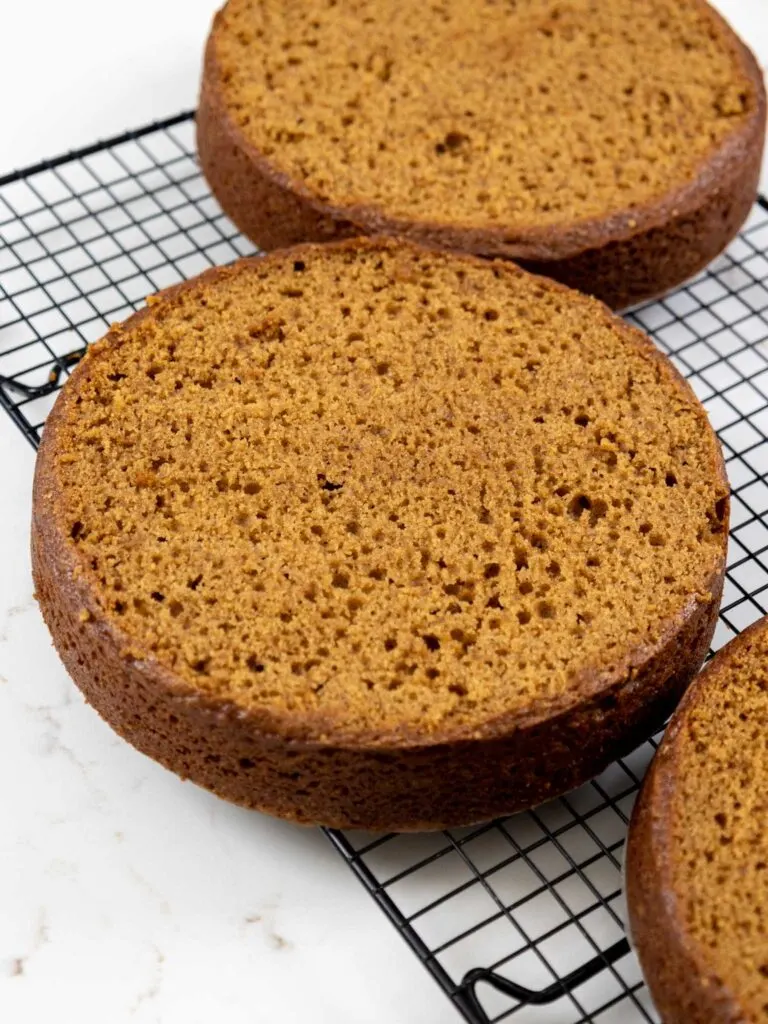
If you’re making these in advance, you can wrap and freeze them at this point.
Step 2: Make the Cream Cheese Frosting
While the cake layers bake and cool, make the cream cheese frosting.
I like to use cream cheese buttercream because I think it’s the easiest to make and I love eating it. However, it is quite sweet!

If you want to use a less sweet frosting, I’d recommend making a batch of my Swiss meringue buttercream or my hybrid buttercream.
This frosting can also be made in advance if needed and kept in the fridge for up to a month.
Step 3: Stack and Fill the Cake Layers
Then it’s time to assemble this cake! Stack and frost cake layers on a greaseproof cake board or flat plate. Use a dab of buttercream to help stick the first cake layer to the board.
Spread an even layer of cream cheese buttercream between each cake layer with a large offset spatula.
Repeat with the remaining cake layers and place the top cake layer upside down to make it easier to frost.
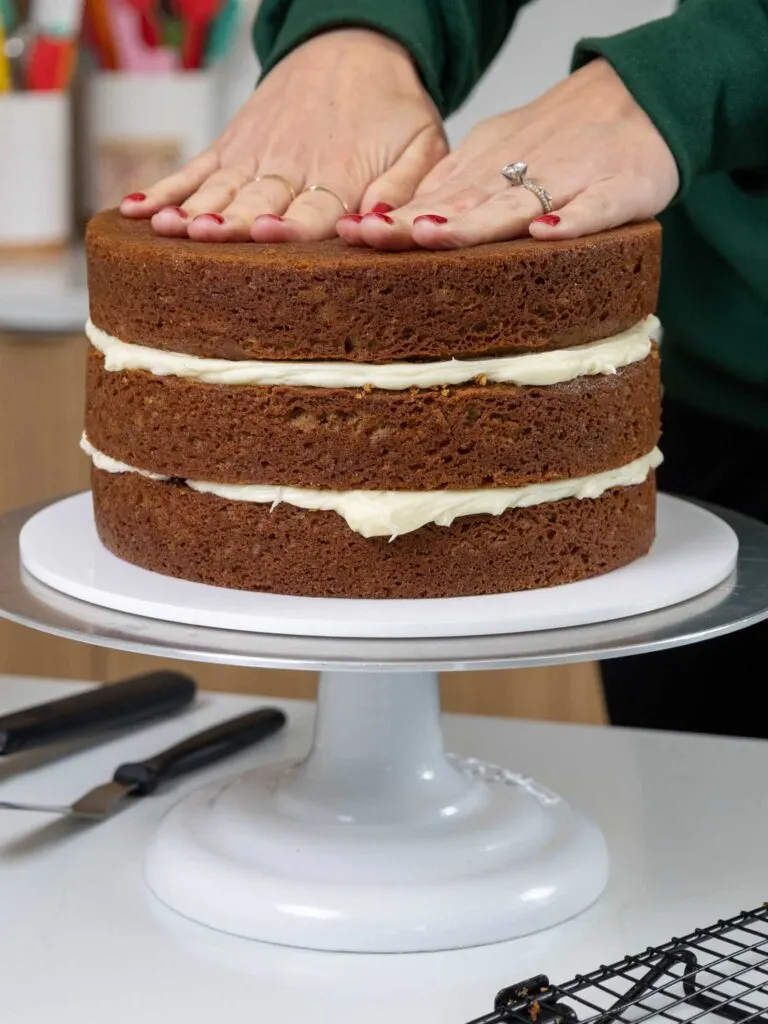
Step 4: Crumb Coat the Cake
Spread a thin coat of frosting around the cake to fully cover the cake layers.
Smooth using a large offset spatula or bench scraper, then chill the cake in the fridge (30 minutes) or freezer (10 minutes) until the frosting is firm to the touch.

Step 5: Add the Second Layer of Frosting & Decorate
Then add a second, thicker layer of frosting to the cake and create a textured look using a large offset spatula.
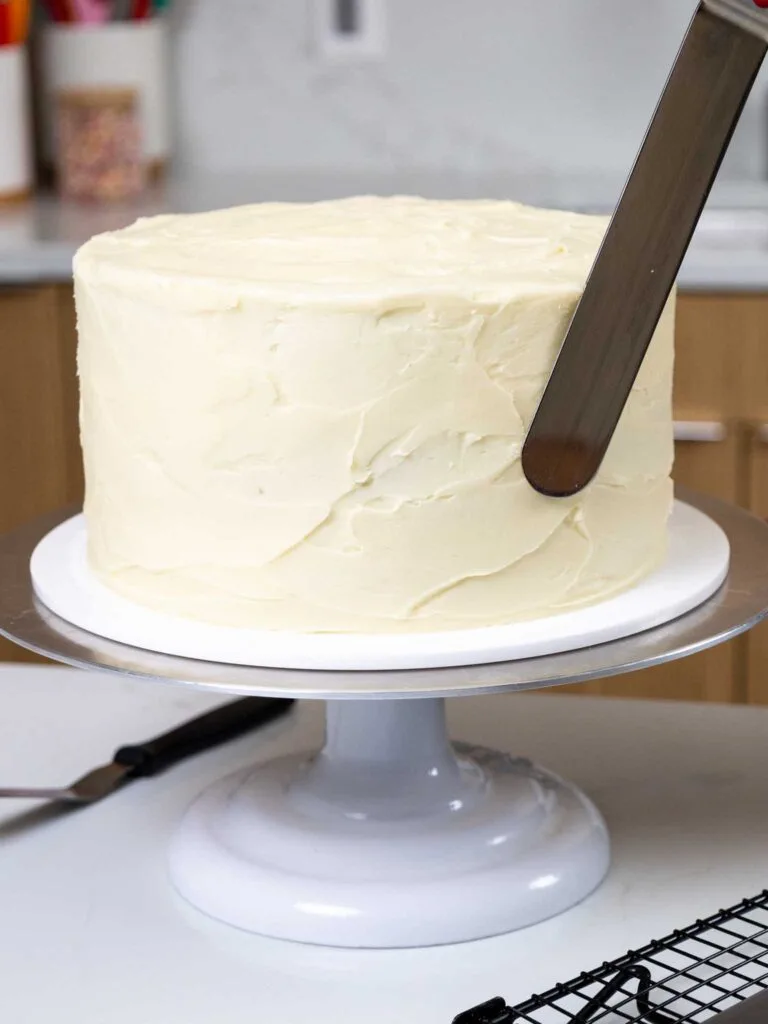
The next steps are totally optional, but I like to add little gingerbread men and hearts around the cake with buttercream!
Scoop 1/2 cup of the remaining buttercream into a small piping bag fitted with a small round piping tip (like a Wilton 3) and set aside.
Color 1/2 cup of frosting red using gel food coloring and place in a small piping bag fitted with a round piping tip (like a Wilton 10).
Add 2 Tbsp of molasses and a squirt of warm brown gel food coloring into the remaining frosting. Then place the brown frosting in a piping bag fitted with a round piping tip (like a Wilton 10) and use it to pipe little gingerbread men all around the cake.
Use the white buttercream to add details onto the gingerbread man and the red buttercream to pipe hearts in any open spaces, then enjoy!

Substitutions and Swaps – Gingerbread Cake Layers
This recipe uses quite a few ingredients and I know you might not have them all on hand. Or if you have food allergies or restrictions, I’ve got you covered.
Below are some swaps and substitutions that can be made in this cake recipe.
- All-Purpose Flour – This recipe turns out best with AP flour, but you can use a gluten-free flour blend or cake flour if that’s all you have on hand.
- Dark Brown Sugar – You can also use light brown sugar in this recipe. I do not recommend reducing the amount of sugar because it will change the texture of the cake layers.
- Unsalted Butter – If you only have salted butter on hand, you can use it in place of the unsalted butter in this recipe. Just be sure to omit the salt that this cake recipe calls for. You can also use vegan butter in its place (and also omit the salt)!
- Egg whites – I like to use the pasteurized egg whites that come in a carton, but you can also use fresh egg whites or 4 whole, large eggs. If you have an egg allergy you can use flaxseed eggs or an egg replacer.
- Sour Cream – You can also use full-fat yogurt, whole milk, or an alternative yogurt or milk (almond, soy, oat) if you’re dairy free.
- Vegetable Oil – You can use any flavorless oil in this recipe. Canola or even sunflower oil would work great!
Substitutions and Swaps – Cream Cheese Buttercream Frosting
- Unsalted Butter – If you only have salted butter on hand, you can use it in place of the unsalted butter. Just be sure to omit the salt that this frosting recipe calls for. You can also use vegan butter in its place (and omit the salt)!
- Cream Cheese – This recipe turns out best if you use full-fat cream cheese that comes in a block.
- Heavy Cream – Whole milk or alternative milk (soy, almond, oat) will work fine in this frosting recipe if that’s what you have on hand.
Making This Gingerbread Layer Cake in Advance and Storage Tips
I recommend making the cake layers in advance and freezing them. It breaks the process up and makes it more approachable.
You can also make your frosting ahead of time too or save any leftover frosting! It can be stored in an airtight container in the fridge for up to a week, or in the freezer for up to a month.
Be sure to give it a good stir once it thaws to get the consistency nice and smooth again.
If you cut into the cake and have leftovers, use any remaining frosting to cover the cut section to keep it moist and store it in the fridge for up to a week.
Tips for Making the Best Gingerbread Cake
- Properly measure your flour. Either spoon it into the cup measure, then level with a knife or use a kitchen scale to measure your dry ingredients.
- Ingredients at room temp mix together better, so be sure to set out any cold ingredients ahead of time.
- Chill your cake layers in the freezer for about 20 minutes before assembling the cake. This makes them easier to stack and frost.
- Level your room temperature or thawed cake layers with a serrated knife to make them easier to stack.
- Make sure your frosting is the right consistency. It makes it so much easier to fill and frost the cake.
- Crumb coat and chill your cake, then smooth on a second layer of frosting. This will help make sure your final coat of frosting is crumb-free and beautiful.
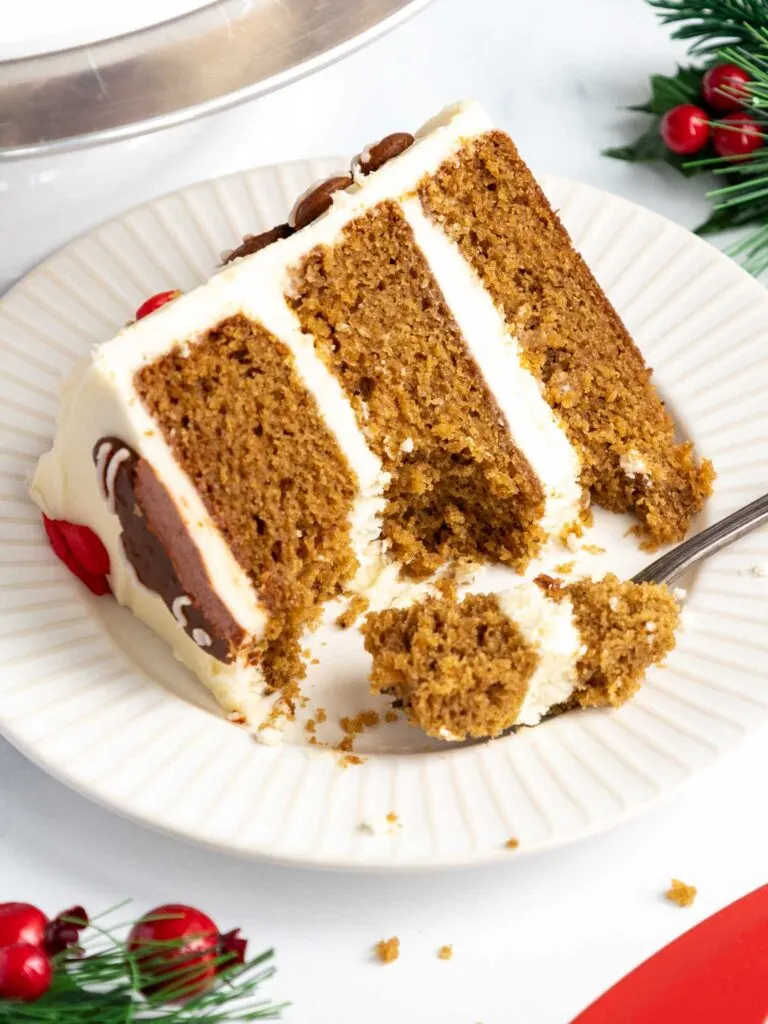
Let Me Know What You Think!
If you make this gingerbread cake recipe, I’d love to hear what you think of it! Let me know by leaving a rating and comment below.
Tag me @chelsweets and use #chelsweets if you share on social media so that I can see your amazing creations.
Other Recipes You Might Like:
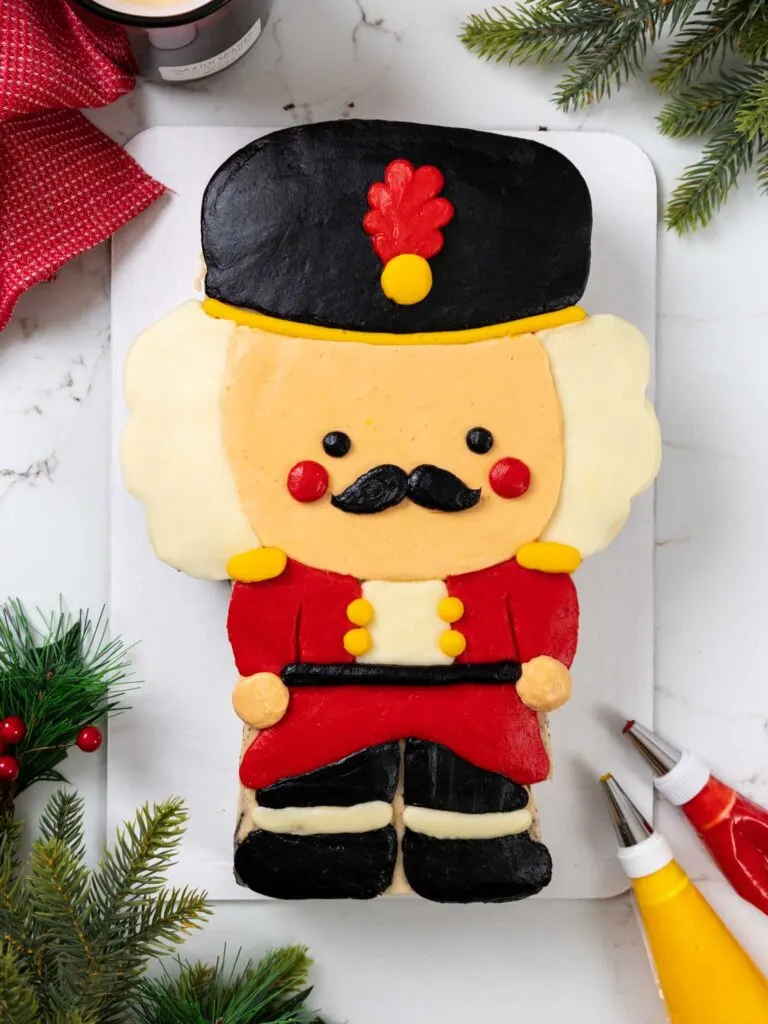


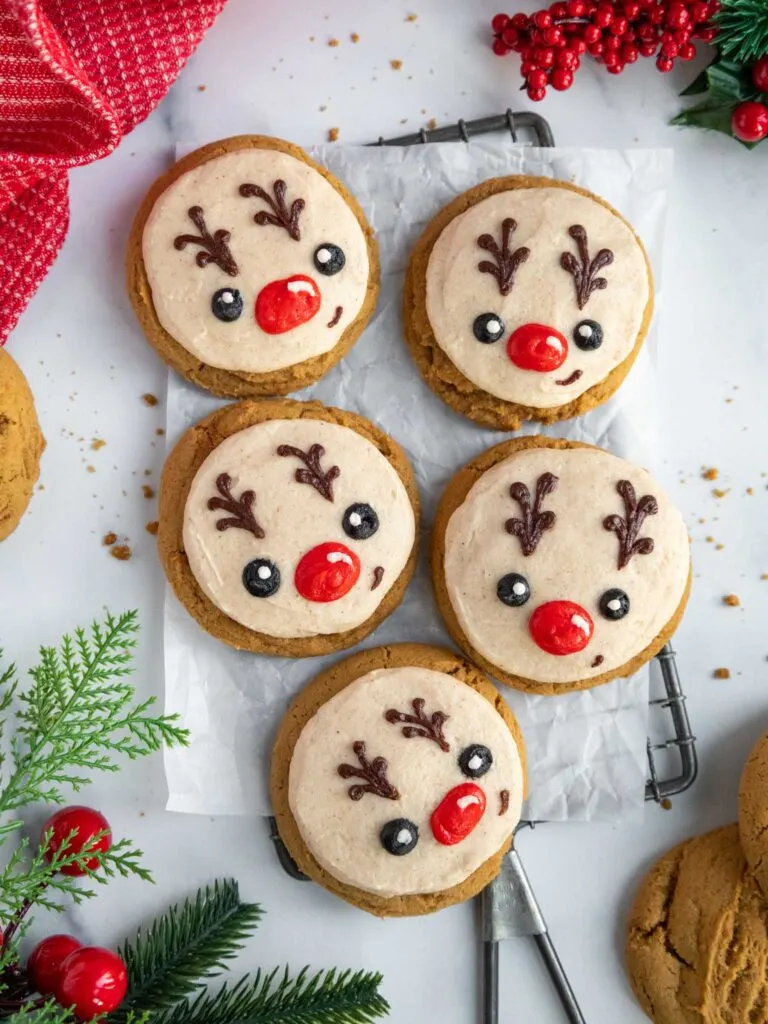
Gingerbread Layer Cake

This gingerbread layer cake is perfect for the holidays! It bakes up so delicious and is frosted with the best cream cheese frosting.
Ingredients
Gingerbread Cake Layers
- 3 cups all-purpose flour (375g)
- 1 1/2 cups granulated sugar (300g)
- 1 1/4 cups packed dark brown sugar (250g)
- 2 Tbsp ground ginger
- 1 Tbsp ground cinnamon
- 2 1/2 tsp baking powder (10g)
- 1 tsp fine salt (6g)
- 1/2 tsp ground cloves
- 1/2 cup unsalted butter, room temperature (113g)
- 1 cup egg whites or 4 large eggs, room temperature (235g)
- 1 1/2 cups sour cream, room temperature (375g)
- 1/2 cup vegetable oil (105g)
- 1/4 cup molasses (70g)
- 1 tsp vanilla extract (4g)
Cream Cheese Buttercream Frosting
- 2 cups or 4 sticks unsalted butter, room temperature (454g)
- 1 cup cream cheese, room temperature (226g)
- 1 Tbsp vanilla extract (12g)
- 1/2 tsp fine salt (3g)
- 10 cups powdered sugar (1250g)
- 1/3 cup heavy cream or whipping cream (80g)
- Brown and red gel food coloring
Recommend Tools and Equipment
Instructions
Gingerbread Layer Cake:
- Preheat the oven to 350°F/175°C. Line three 8" cake pans with parchment rounds and grease with non-stick baking spray.
- Mix together 3 cups flour, 1 1/2 cups granulated sugar, 1 1/4 cups dark brown sugar, 2 Tbsp ginger, 1 Tbsp cinnamon, 2 1/2 tsp baking powder, 1 tsp salt, and 1/2 tsp cloves in a large bowl until fully combined.
- Mix 1/2 cup of unsalted butter slowly into the dry ingredients on a low speed. Continue to mix until no large chunks of butter remain.
- Mix in 1 cup of egg whites on a medium speed until incorporated.
- Add 1 1/2 cups sour cream, 1/2 cup vegetable oil, 1/4 cup molasses, and 1 tsp of vanilla extract. Mix on a low speed until incorporated.
- Scrape down the sides of the bowl with a rubber spatula, then beat on a medium speed for about a minute to make sure everything is properly mixed together.
- Divide the batter evenly between the prepared pans and bake for 31-34 minutes or until a toothpick comes out with a few moist crumbs. Let the cake layers cool in the pans for 10 minutes, then run a small offset spatula around the perimeter of the pan to separate the cake from the pan.
- Flip the cake layers onto a wire rack to cool. Use a serrated knife to level the top of the layers once they're fully cooled.
- If you make these cake layers in advance and freeze them, let them thaw for about 20 minutes before making your cake. The cake layers should still be cold to the touch, which will make it easier to assemble your cake.
Cream Cheese Buttercream Frosting:
- While the cake layers bake and cool, make the cream cheese buttercream frosting.
- Beat 2 cups (4 sticks) of butter and 1 cup of cream cheese on a medium speed for 30 seconds with a paddle attachment or hand mixer until smooth.
- Mix in 1 Tbsp of vanilla extract and 1/2 tsp of salt on a low speed.
- Gradually mix in 10 cups of powdered sugar and 1/3 cup of heavy cream on a low speed.
- If the frosting seems too thick, add in additional cream (1 TBSP at a time). If the frosting is too thin, add in more powdered sugar (quarter of a cup at a time). If you're not sure what consistency the frosting should be, check out my frosting consistency post. Wait to color the buttercream until the cake is stacked and frosted.
Assembling This Gingerbread Cake:
- Stack and frost the cake layers on a greaseproof cake board or flat plate using a dab of frosting to help stick the first cake layer to the board.
- Spread an even layer of cream cheese buttercream between each cake layer with a large offset spatula.
- Add a thin coat of frosting around the cake to fully cover the cake layers. Smooth using a large offset spatula or bench scraper, then chill the cake in the fridge (30 minutes) or freezer (10 minutes) until the frosting is firm to the touch.
- Then add a second, thicker layer of frosting to the cake and create a textured look using a large offset spatula.
- The next steps are totally optional, but I like to add little gingerbread men and hearts around the cake with buttercream! To do this, scoop 1/2 cup of the remaining buttercream in a small piping bag fit with a small round piping tip (like a Wilton 3) and set aside.
- Color 1/2 cup of frosting red using gel food coloring and place in a small piping bag fit with a round piping tip (like a Wilton 10).
- Add 2 Tbsp of molasses and a squirt of warm brown gel food coloring into the remaining frosting. Then place the brown frosting in a piping bag fit with a round piping tip (like a Wilton 10) and use it to pipe little gingerbread men all around the cake.
- Use the white buttercream to add details onto the gingerbread man and the red buttercream to pipe hearts in any open spaces, then enjoy!
Notes
Making this Gingerbread Layer Cake in Different Sizes
One batch of batter is about 1800g, so I add roughly 600g to each of my cake pans (when using 3, 8-inch cake pans).
You can also use one batch of batter to make 2, 9-inch cake layers or 4, 6-inch cake layers.
I recommend using this recipe if you want to make a gingerbread sheet cake.
If you want to make gingerbread cupcakes, bake them at 350F / 175C for 18-21 minutes. One batch of batter will make about 3 dozen cupcakes (yield will vary based on the size of your liners).
Tips for Making the Best Gingerbread Layer Cake:
- Properly measure your flour (spoon into the cup measure, then level) or use a kitchen scale to measure your dry ingredients.
- Ingredients at room temperature mix together better. Set out any cold ingredients ahead of time.
- Chill the cake layers in the freezer for about 20 minutes before assembling the cake. This makes it a lot easier to stack and frost.
- Make a vegan or dairy free gingerbread cake if needed! Use your favorite type of dairy free milk to replace the sour cream and heavy cream and use vegan butter sticks in place of the butter. For the egg whites I recommend using a powdered egg replacer.
- If your hands run hot, wrap a paper towel, or thin kitchen towel around your piping bag to prevent the transfer of heat from your hands into the frosting.
Making This Gingerbread Layer Cake in Advance and Storage Tips
Make the cake layers in advance and freeze them. This breaks the process up and makes this recipe more approachable.
You can make the frosting ahead of time too or save any leftover frosting! It can be stored in an airtight container in the fridge for up to a month or in the freezer for up to 3 months. Be sure to give it a good stir once it thaws to get the consistency nice and smooth again.
This cake can sit out at room temp for a few hours, in the fridge for up to 5 days, or in the freezer for up to a month.
Nutrition Information
Yield
24Serving Size
1Amount Per Serving Calories 671Total Fat 34gSaturated Fat 17gTrans Fat 0gUnsaturated Fat 14gCholesterol 111mgSodium 292mgCarbohydrates 89gFiber 1gSugar 74gProtein 5g

Chandra
Thursday 5th of January 2023
Can you use fresh ginger in place of dried ginger? If so how much fresh ginger should I use?
Chelsweets
Sunday 8th of January 2023
Hi Chandra,
Great question! You can totally do that! You'll just need to use more fresh ginger because ground ginger is more concentrated. For every 1/4 teaspoon of ground ginger, use 1 tablespoon of fresh-grated ginger in this recipe. Hope that helps, happy baking!
MacKenzie
Tuesday 20th of December 2022
How long would it have to bake if I were to split it into three 7” pans or four 6” pans?
Chelsweets
Friday 23rd of December 2022
Hi MacKenzie,
Great question! I'd recommend baking it for 3-7 minutes longer than the recipe calls for. Hope that helps happy baking!
Emily Horne
Sunday 11th of December 2022
Do you know about how many cups this batter makes? Wanting to put this into a 9 cup gingerbread house bundt cake. Thanks!
Chelsweets
Sunday 18th of December 2022
Hi Emily,
Apologies for the delayed response! This recipe makes about 10 cups of batter. Happy baking!!